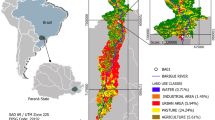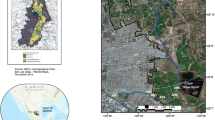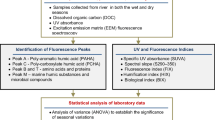Abstract
The fluorescent properties of dissolved organic matter (DOM) have been used as natural tracers in various water systems. However, only few studies have focused on groundwater systems, specifically, on karst systems. The aim of this study was to develop the use of the DOM fluorescence signal as a natural tracer, considering the multiple compartments of a karst system. This method was applied to the Lez hydrosystem, which supplies the city of Montpellier with drinking water. The hydrodynamics and hydrochemistry of the spring were monitored beginning March 2006. The DOM fluorescence was measured by the excitation–emission matrix spectroscopy technique. The analysis of the total fluorescence signal confirms the efficiency of this tool to trace rapid infiltration flows. Moreover, the decomposition of the signal into different fluorophores complements the information provided by the total signal. Indeed, the fluorescence emitted by the humic compounds seems to be the ideal tool for identifying rapid infiltration flows. Nevertheless, the fluorescence of protein-like compounds is better correlated with the inflow of faecal bacteria at the outlet. This decomposition of the fluorescence signal is an interesting way to provide information on both the rapid infiltration flow as well as the vulnerability of the karst aquifers.



Similar content being viewed by others
Abbreviations
- DOM:
-
Dissolved organic matter
- EEM:
-
Excitation–emission matrix
- EC:
-
Electrical conductivity
- TOC:
-
Total organic carbon
- HL:
-
Humic-like
- PL:
-
Protein-like
References
Ariese F, van Assema S, Gooijer C, Bruccoleri AG, Langford CH (2004) Comparison of Laurentian fulvic acid luminescence with that of the hydroquinone/quinone model system: evidence from low temperature fluorescence studies and EPR spectroscopy. Aquat Sci 66:86–94
Baker A (2002) Fluorescence excitation–emission matrix characterization of river waters impacted by a tissue mill effluent. Environ Sci Technol 36(7):1377–1382
Baker A, Genty D (1999) Fluorescence wavelength and intensity variations of cave waters. J Hydrol 217:19–34
Baker A, Lamont-Black J (2001) Fluorescence of dissolved organic matter as a natural tracer of ground water. Ground Water 39:745–750
Batiot C, Emblanch C, Blavoux B (2003) Carbone organique total (COT) et magnésium (Mg2+): deux traceurs complémentaires du temps de séjour dans l’aquifère karstique. C R Géosci 335:205–214
Batiot-Guilhe C, Seidel JL, Lafare A, Jourde H, Cordier MA, Van-Exter S, Rodier C (2008) Characterisation of underground flows in karstic aquifers by studying DOM fluorescence. Example of two Mediterranean systems (Lez and Causse d’Aumelas, Southeastern France). 13th IWRA World Water Congress, Montpellier
Bicalho CC, Batiot-Guilhe C, Seidel JL, Van-Exter S, Jourde H (2012) Geochemical evidence of water source characterisation and hydrodynamic responses in a karst aquifer. J Hydrol 450–451:206–218
Blondel T (2008) Traçage spatial et temporel des eaux souterraines dans les hydrosystèmes karstiques par les matières organiques dissoutes. PhD Thesis. Académie d'Aix-Marseille. Université d'Avignon et des Pays de Vaucluse
Blondel T, Batiot-Guilhe C, Emblanch C, Dudal Y (2006) Perspectives sur l’utilisation de la fluorescence de la matière organique dissoute comme traceur quantitatif du temps de séjour dans un système karstique méditerranéen. Application au Laboratoire Souterrain à Bas Bruit de Rustrel (France). Proceedings of the 8th conference on limestone hydrogeology, Neuchâtel, ISBN2-84867-143-2, Presses universitaires de Franche-Comté, 11–14
Cammack WKL, Kalf J, Prairie YT, Smith EM (2004) Fluorescent dissolved organic matter in lakes: relationship with heterotrophic metabolism. Limnol Oceanogr 49(6):2034–2045
Carstea EM, Baker A, Bieroza M, Reynolds D (2010) Continuous fluorescence excitation–emission matrix monitoring of river organic matter. Water Res 44(18):5356–5366
Charlier JB, Mudry J, Bertrand C (2010) Use of dissolved organic carbon to characterize infiltration in a small karst system in the French Jura Mountains (Fertans, France). In: Andreo B (ed) Advances in research in karst media. Springer, Berlin, pp 151–156
Chen W, Westerhoff P, Leenheer JA, Booksh K (2003) Fluorescence excitation–emission matrix regional integration to quantify spectra for dissolved organic matter. Environ Sci Technol 37:5701–5710
Coble PG (1996) Characterisation of marine and terrestrial DOM in seawater using excitation–emission spectroscopy. Mar Chem 51:325–346
Cory RM, McKnight DM (2005) Fluorescence spectroscopy reveals ubiquitous presence of oxidized and reduced quinones in dissolved organic matter. Environ Sci Technol 39:8142–8149
Cruz FW Jr, Karmann I, Magdaleno GB, Coichev N, Viana O Jr (2005) Influence of hydrological and climatic parameters on spatial-temporal variability of fluorescence intensity and DOC of karst percolation waters in the Santana Cave System, Southeastern Brazil. J Hydrol 302:1–12
Drogue C (1969) Contribution à l’étude quantitative des systèmes hydrologiques karstiques d’après l’exemple de quelques karsts périméditerranéens. Thèse Doct, Sci, Nat, Montpellier
Elliott S, Lead JR, Baker A (2006) Thermal quenching of fluorescence of freshwater, planktonic bacteria. Anal Chim Acta 564:219–225
Ford DC, Williams PW (2007) Karst hydrogeology and geomorphology. Wiley, Chichester
Hartland A, Fairchild IJ, Lead JR, Baker A (2010) Fluorescent properties of organic carbon in cave dripwaters: effects of filtration, temperature and pH. Sci Total Environ 408:5940–5950
He Z, Zhao W, Liu H, Chang X (2012) The response of soil moisture to rainfall event size in subalpine grassland and meadows in a semi-arid mountain range: a case study in northwestern China’s Qilian Mountains. J Hydrol 420–421:183–190
Hudson N, Baker A, Reynolds D (2008) Fluorescence analysis of dissolved organic matter in natural, waste and polluted waters—a review. River Res Appl 23:631–649
Huguet A, Vacher L, Relexans S, Saubusse S, Froidefond JM, Parlanti E (2009) Properties of fluorescent dissolved organic matter in the Gironde Estuary. Org Geochem 40(6):706–719
Jiang Y, Yan J (2010) Effects of land use on hydrochemistry and contamination of karst groundwater from Nandong underground river system, China. Water Air Soil Poll 210:123–141
Mahler B, Massei N (2007) Anthropogenic contaminants as tracers in an urbanizing karst aquifer. J Contam Hydrol 91:81–106
Marjolet G, Salado J (1976) Contribution à l’étude de l’aquifère karstique de la source du Lez (Hérault). Étude du chimisme des eaux de la source du Lez et de son bassin. Tome IX—FASC II. Mémoire du centre d’études et de 52 recherches géologiques et Hydrogéologiques Montpellier Université des sciences et Techniques du Languedoc (Montpellier II)
Mudarra M, Andreo B, Baker A (2011) Characterization of dissolved organic matter in karst spring waters using intrinsic fluorescence: relationship with infiltration processes. Sci Total Environ 409(18):3448–3462
Nguyen M-L, Westerhoff P, Baker L, Hu Q, Esparza-Soto M, Sommerfield M (2005) Characteristics and reactivity of algae-produced dissolved organic carbon. J Environ Eng 131(11):1574–1582
Niemela SI, Lee JV, Fricker CR (2003) A comparison of the international standards organization reference method for the detection of coliforms and Escherichia coli in water with a defined substrate procedure. J Appl Microbiol 95:1285–1292
Parlanti E, Worz K, Geoffroy L, Lamotte M (2000) Dissolved organic matter fluorescence spectroscopy as a tool to estimate biological activity in a coastal zone submitted to anthropogenic inputs. Org Geochem 31(12):1765–1781
Pronk M, Goldscheider N, Zopfi J (2006) Dynamics and interaction of organic carbon, turbidity and bacteria in a karst aquifer system. Hydrogeol J 14:473–484
Pronk M, Goldscheider N, Zopfi J, Zwahlen F (2009) Percolation and particle transport in the unsaturated zone of a karst aquifer. Ground Water 47(3):361–369
Savoy L (2007) Use of natural and artificial reactive tracers to investigate the transfer of solutes in karst systems. PhD. Thesis, University of Neuchâtel, Switzerland
Schnegg PA (2003) A new field fluorometer for multi-tracer tests and turbidity measurement applied to hydrogeological problems. In: Proceedings of the eighth international congress of the Brazilian geophysical society, Rio de Janeiro
Senesi N (1993) In: Bech AJ, Jones KC, Hayes MBH, Mingelgrin U (eds) Organic substances in soil and water: natural constituents and their influences on contaminant behaviour. The Royal Society of Chemistry, Cambridge, p 4
Stephenson JB, Zhou WF, Beck BF, Green TS (1999) Highway stormwater runoff in karst areas—preliminary results of baseline monitoring and design of a treatment system for a sinkhole in Knoxville, Tennessee. Eng Geol 52:51–59
Thierry D, Bérard P (1983) Alimentation en eau de la ville de Montpellier—Captage de la source du Lez—études des relations entre la source et son réservoir aquifère. Rapport no 1, Rapport 83 SGN 167 LRO. Montpellier, BRGM
Tissier G, Perrette Y, Dzikowski M, Poulenard J, Hobléa F, Malet E, Fanget B (2013) Seasonal changes of organic matter quality and quantity at the outlet of a forested karst system (La Roche Saint Alban, French Alps). J Hydrol 482:139–148
Urban-Rich J, McCarty JT, Fernández D, Acuña JL (2006) Larvaceans and copepods excrete fluorescent dissolved organic matter (FDOM). J Exp Mar Biol Ecol 332:96–105
Van Beynen P, Ford D, Schwarcz H (2000) Seasonal variability in organic substances in surface and cave waters at Marengo Cave, Indiana. Hydrol Process 14:1177–1197
Zsolnay A, Baigar E, Jimenez M, Steinweg B, Saccomandi F (1999) Differentiating with fluorescence spectroscopy the sources of dissolved organic matter in soils subjected to drying. Chemosphere 38(1):45–50
Author information
Authors and Affiliations
Corresponding author
Rights and permissions
About this article
Cite this article
Quiers, M., Batiot-Guilhe, C., Bicalho, C.C. et al. Characterisation of rapid infiltration flows and vulnerability in a karst aquifer using a decomposed fluorescence signal of dissolved organic matter. Environ Earth Sci 71, 553–561 (2014). https://doi.org/10.1007/s12665-013-2731-2
Received:
Accepted:
Published:
Issue Date:
DOI: https://doi.org/10.1007/s12665-013-2731-2




